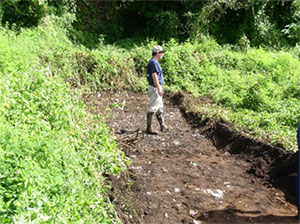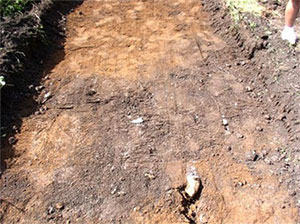 |
November 15, 2004
7 a.m., Saipan
Having understood the fieldwork to be at an end and with Mike, Randy and Marilyn packing up to catch the 1 pm ferry to Saipan, it was a surprise to learn – when we more or less stumbled over Jennings, Mr. Naftel, Bob and others at Sunday breakfast yesterday – that they were planning to re-engage the equipment operator and do some more digging. The machine was still on site, and they had John Mark to provide archaeological oversight on behalf of the HPO, and Hiro and his students were still around, so, the implicit conclusion was, why not do some exploration? The idea was to run some trenches in the field east of the site, perpendicular to the cliff face, to see if they could intersect the old road, establish where it turned toward the west – it being in this turn that Mr. Naftel said he’d been shown the graves – and then explore the area around the turn.
Mike had washed his hands of it, viewing the project as no longer a piece of archaeological research but mere stabbing in the dark. He, Marilyn and Randy were concerned about possible damage to prehistoric sites in the area. But, as Mike put it, if Jennings and his colleagues wanted to do it under their permit, and the HPO – represented by John Mark – was willing to go along, he just hoped they’d keep proper records of what they found. I drove to the site and found work in progress, and Hiro and his students carefully mapping in what was being done, so things appeared to be under reasonable control.
 |
| First trench. Photo by Tom King. |
From what I saw in a couple of visits over the course of the morning, they dug four long trenches across the field, and may or may not have uncovered some evidence of a road. Right where the talus slope from the cliff meets the sand, there was a strip of small-sized more or less crushed coral, but whether this was road metal or just talus deposit wasn’t clear, and even the equipment operator, who works on road building projects, couldn’t seem to verify that there was really a road there. If there WAS a road, and it was at the foot of the talus slope, it was hard to see how there could have been graves between the road and the escarpment; they’d have been dug into the coral talus itself, and not into the sand deposit that would have created the sorts of mounds Mr. Naftel described.
A pit did turn up in the first trench, just southeast of the site we’d stripped – a somewhat irregular pit in the sand deposit, with a bottle and some Japanese porcelain sherds in it. It was diagnosed as a refuse pit, and not excavated, but Hiro and his students mapped it.
 |
| Pit feature in trench. Photo by Tom King. |
Conclusions: Like other pursuits of anecdotal accounts, this one was thwarted by ambiguities. It turned out that the location of Mr. Naftel’s road was not as certain as it had seemed. The landscape of the area has been pushed around and reorganized, and of course heavily overgrown. As a result, the depressions he had identified with such certainty as representing the graves most likely did not – though of course, it’s always possible that someone dug up whoever was in them years ago.
I don’t think that bones were bulldozed up and deposited in the berm, or in any other area we scraped. Bones preserve well in this environment, and if a couple of skeletons had been bulldozed up, at least a bone or two should have popped up during the grading and dissection of the berm. The students collected dozens of artifacts – bottles, porcelain, some quite hard-to-spot ferrous items – so they should have seen a bone if it had been there. The graves could of course have been in one of the patches we didn’t dig – right under the canopy where Hiro and his students sorted the artifacts, for example, or under the roots of one of the big trees that we didn’t remove. But they could be in innumerable other places, too.
Did Mr. Naftel see graves? I trust him; I think he did – or at least, he saw mounds that he was told were graves. Were they at the site we dug? Maybe. Were they Earhart’s and Noonan’s? Well, all I can say is that nothing’s happened on the Tinian project to lessen my belief that the Nikumaroro Hypothesis is the best game in town.
